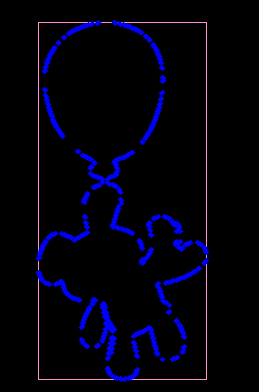[Opencv]几种对轮廓的处理方式
Posted lx17746071609
tags:
篇首语:本文由小常识网(cha138.com)小编为大家整理,主要介绍了[Opencv]几种对轮廓的处理方式相关的知识,希望对你有一定的参考价值。
boundingRect()
作用:计算点集的右上边框。
形式:boundingRect(InputArray points);
参数:points:输入二维点集,并用std::vector or Mat存储;
points:输入信息,可以为包含点的容器(vector)或是Mat。
返回包覆输入信息的最小正矩形。如下图:

RotateRect minAreaRect(InputArray points)
作用:生成最小外接矩形
points,输入信息,可以为包含点的容器(vector)或者是Mat
mat input=img.clone()//img图像为预处理后的二值化图像
vector<vector<Point> > contours;
vector<Vec4i> hierarchy;//存储查找到的第i个轮廓的后[i][0]、前[i][1]、父[i][2]、子轮廓[i][3]
findContours(input, contours, hierarchy, RETR_CCOMP, CHAIN_APPROX_SIMPLE);
RotatedRect r= minAreaRect(contours[i]);
minEnclosingCircle() 作用:找到包围二维点集面积最小的圆。 形式:void minEnclosingCircle(InputArray points, Point2f& center, float& radius); 参数: points:输入二维点集,并用std::vector or Mat存储; center:输出圆的中心; radius:输出圆的半径; approxPolyDP() 作用:以特定精度近似发出多边形曲线。 形式:void approxPolyDP(InputArray curve, OutputArray approxCurve, double epsilon, bool closed); 参数: curve:输入一个在std::vector or Mat中存储的二维点向量; approxCurve:近似的结果即输出; epsilon:规定估计精度的参数; closed:如果是true:估计的曲线是封闭的,如果是false:估计的曲线不是封闭的; rectangle() 作用:画一个简单、明显或充满的右上角矩形。 形式:void rectangle(Mat& img, Point pt1, Point pt2, const Scalar& color, int thickness=1, int lineType=8, int shift=0); 参数: img:处理的对象图片; pt1:矩形的顶点; pt2:与pt1相对的矩形的顶点; color:矩形的颜色或亮度; thickness:矩形的边线的粗细,像CV_FILLED的负值,意味着要画一个填充的矩形; lineType:矩形的边线的类型; shift:坐标点的小数位; circle() 作用:画一个圆。 形式:void circle(Mat& img, Point center, int radius, const Scalar& color, int thickness=1, int lineType=8, int shift=0); 参数和rectangle()的设置类似,这里不再赘述。
#include "opencv2/imgproc/imgproc.hpp" #include <iostream> #include <stdio.h> #include <stdlib.h> using namespace cv; using namespace std; Mat src; Mat src_gray; int thresh = 100; int max_thresh = 255; RNG rng(12345); /// 函数声明 void thresh_callback(int, void* ); /** @主函数 */ int main( int argc, char** argv ) /// 载入原图像, 返回3通道图像 src = imread( argv[1], 1 ); /// 转化成灰度图像并进行平滑 cvtColor( src, src_gray, CV_BGR2GRAY ); blur( src_gray, src_gray, Size(3,3) ); /// 创建窗口 char* source_window = "Source"; namedWindow( source_window, CV_WINDOW_AUTOSIZE ); imshow( source_window, src ); createTrackbar( " Threshold:", "Source", &thresh, max_thresh, thresh_callback ); thresh_callback( 0, 0 ); waitKey(0); return(0); /** @thresh_callback 函数 */ void thresh_callback(int, void* ) Mat threshold_output; vector<vector<Point> > contours; vector<Vec4i> hierarchy; /// 使用Threshold检测边缘 threshold( src_gray, threshold_output, thresh, 255, THRESH_BINARY ); /// 找到轮廓 findContours( threshold_output, contours, hierarchy, CV_RETR_TREE, CV_CHAIN_APPROX_SIMPLE, Point(0, 0) ); /// 多边形逼近轮廓 + 获取矩形和圆形边界框 vector<vector<Point> > contours_poly( contours.size() ); vector<Rect> boundRect( contours.size() ); vector<Point2f>center( contours.size() ); vector<float>radius( contours.size() ); for( int i = 0; i < contours.size(); i++ ) approxPolyDP( Mat(contours[i]), contours_poly[i], 3, true ); boundRect[i] = boundingRect( Mat(contours_poly[i]) ); minEnclosingCircle( contours_poly[i], center[i], radius[i] ); /// 画多边形轮廓 + 包围的矩形框 + 圆形框 Mat drawing = Mat::zeros( threshold_output.size(), CV_8UC3 ); for( int i = 0; i< contours.size(); i++ ) Scalar color = Scalar( rng.uniform(0, 255), rng.uniform(0,255), rng.uniform(0,255) ); drawContours( drawing, contours_poly, i, color, 1, 8, vector<Vec4i>(), 0, Point() ); rectangle( drawing, boundRect[i].tl(), boundRect[i].br(), color, 2, 8, 0 ); circle( drawing, center[i], (int)radius[i], color, 2, 8, 0 ); /// 显示在一个窗口 namedWindow( "Contours", CV_WINDOW_AUTOSIZE ); imshow( "Contours", drawing );
以上是关于[Opencv]几种对轮廓的处理方式的主要内容,如果未能解决你的问题,请参考以下文章